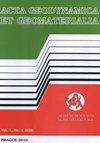Structural framework of the Zelten platform, south Sirte Basin, Libya using Potential Fields modelling
IF 0.8
4区 地球科学
Q4 GEOCHEMISTRY & GEOPHYSICS
引用次数: 4
Abstract
Integration between magnetic and gravity data at the Zelten platform, the southeast part of Sirt Basin Libya. Zelten Platform is first discovered oil field in Libya. It shows numerous geological structures of different tectonic events. The methods adopted can assist in locating the hidden subsurface structures. The platform is characterized by the NW-SE trending rift that belongs to the Early Cretaceous age (during the collapse of Sirt Arch). The study aimed to define the structural geology that assisted in the development of future exploration in this area. The analyses utilized several filtering and transformation algorithms to help in structural modeling. For instance, the total horizontal gradient and tilt angle derivative were applied for the edge detection of the tectonic boundaries. The results show NW-SE and NNW-SSE patterns that represents faults that controlled the positions of the troughs and platforms at the Sirt basin. On the other hand, Euler deconvolution and 2D forward modeling were utilized to determine the depth of the basement. The Integrated models deduced revealed that the main faults trends are NW-SE which refer to the rift phases and crustal extension period that occurred during the Mesozoic time (early cretaceous). Also, the basement depth ranges from 6.5 km to 8 km according to the structures that affected the study使用势场建模的利比亚苏尔特盆地南部Zelten平台的结构框架
利比亚Sirt盆地东南部Zelten地台磁重资料整合Zelten平台是利比亚第一个发现的油田。它显示了许多不同构造事件的地质构造。所采用的方法可以帮助定位隐藏的地下结构。台地以早白垩世(西特拱崩塌时期)北西-东南向裂谷为特征。该研究旨在确定构造地质学,以帮助该地区未来勘探的发展。分析使用了几种滤波和转换算法来帮助进行结构建模。例如,利用总水平梯度和倾角导数对构造边界进行边缘检测。结果表明,锡尔特盆地NW-SE型和NNW-SSE型断裂控制了槽台位置。另一方面,利用欧拉反褶积和二维正演模拟确定基底深度。综合模型表明,主要断裂走向为NW-SE,与中生代(早白垩世)裂谷期和地壳伸展期有关。根据影响研究的构造,基底深度在6.5 ~ 8 km之间
本文章由计算机程序翻译,如有差异,请以英文原文为准。
求助全文
约1分钟内获得全文
求助全文
来源期刊

Acta Geodynamica et Geomaterialia
地学-地球化学与地球物理
CiteScore
2.30
自引率
0.00%
发文量
12
期刊介绍:
Acta geodynamica et geomaterialia (AGG) has been published by the Institute of Rock Structures and Mechanics, Czech Academy of Sciences since 2004, formerly known as Acta Montana published from the beginning of sixties till 2003. Approximately 40 articles per year in four issues are published, covering observations related to central Europe and new theoretical developments and interpretations in these disciplines. It is possible to publish occasionally research articles from other regions of the world, only if they present substantial advance in methodological or theoretical development with worldwide impact. The Board of Editors is international in representation.
 求助内容:
求助内容: 应助结果提醒方式:
应助结果提醒方式:


